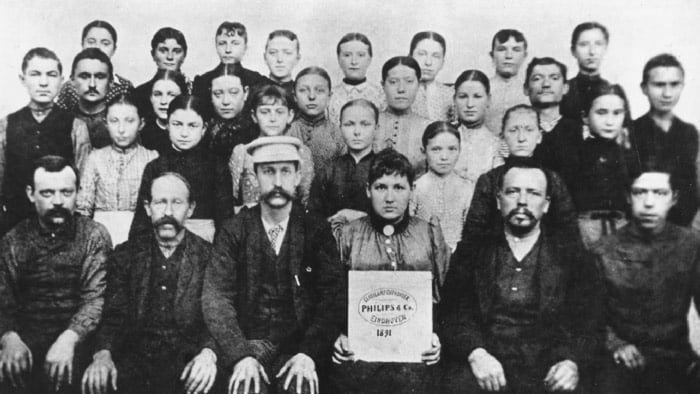Philips has become a household name synonymous with cutting-edge technology, continually shaping industries through its relentless innovation. Over the course of its history, the company has transitioned from a small Dutch start-up to a global leader in health technology, lighting, and consumer electronics. In this article, we’ll explore how Philips’ journey unfolded, driving its rise to prominence and its current leadership in the health and lighting sectors.
The Birth of Philips: A Modest Start
The story of Philips begins in 1891 in Eindhoven, Netherlands, when Gerard Philips and his father Frederik Philips founded the company. The initial focus of the company was on the production of carbon-filament lamps, a burgeoning industry at the time. However, the company faced immediate challenges, including financial instability and fierce competition from larger manufacturers. Despite these early hurdles, the founders’ commitment to quality laid the groundwork for Philips’ future success. Over the years, the company would innovate, evolve, and expand to become a global powerhouse.
Philips' first major breakthrough was its ability to manufacture high-quality lamps at a competitive price, which quickly garnered attention. This early success allowed the company to expand its operations beyond the Netherlands and build a reputation for craftsmanship and innovation. The company’s trajectory would continue to climb as it embraced new technologies and ventured into new markets.
Early Milestones in Innovation
By the turn of the 20th century, Philips had established itself as a key player in the European lighting market. However, it was the creation of the company’s Research Laboratory (NatLab) in 1914 that truly set Philips on its path toward being an innovation leader. NatLab became the epicenter of the company’s groundbreaking developments, allowing Philips to diversify its offerings and remain ahead of the curve in technological advancements.
The lab’s influence was immense, paving the way for several major technological breakthroughs that would shape the future of the company. Philips’ focus on research and development (R&D) proved to be a critical factor in its long-term success, fostering a culture of innovation that would continue to define the company for decades.
Expanding into Radio Technology
The 1920s and 1930s were a period of diversification for Philips. The company recognized the growing potential of radio technology and entered the burgeoning radio industry in 1927. The radio became a powerful medium for communication, and Philips quickly capitalized on this trend. By 1932, Philips had sold over a million radios, establishing itself as a major player in the consumer electronics market.
This success demonstrated Philips’ ability to anticipate consumer needs and adapt to emerging trends. By venturing into radio technology, Philips set the stage for future expansions into other consumer electronics and entertainment industries, solidifying its reputation as a company capable of both innovation and mass production.
Overcoming Wartime Challenges: Innovation Amidst Adversity
World War II brought tremendous challenges to Philips, disrupting operations and damaging manufacturing facilities. Yet, the company exhibited remarkable resilience. Philips relocated key personnel and resources to ensure that essential research and development continued despite the chaos of the war. During this period, the company contributed to advancements in radar technology, showcasing its ability to innovate even in times of crisis.
Philips' wartime contributions extended beyond radar technology. The company also played a pivotal role in producing medical equipment for the war effort. This commitment to technological innovation during a period of immense hardship highlighted the company’s dedication to pushing the boundaries of what was possible, even when faced with seemingly insurmountable challenges.
The Post-War Innovation Boom: The Audio Cassette Revolution
After the war, Philips once again demonstrated its ability to lead in innovation. In 1963, the company introduced the compact audio cassette, a product that would revolutionize the music industry. The cassette provided consumers with an easy and portable way to record and play music, and its success became a defining moment for Philips. The compact cassette's global success solidified Philips’ reputation as an industry leader in consumer electronics.
The cassette would go on to become the standard format for portable music for decades, making it one of Philips' most significant contributions to the entertainment industry. This breakthrough demonstrated the company's foresight in recognizing emerging trends and capitalizing on them to meet consumer demand.
Shaping the Future of Music: The Compact Disc Partnership
In the late 1970s, Philips formed a strategic partnership with Sony to develop the compact disc (CD), a product that would reshape the music industry once again. The CD offered a new way to enjoy music with superior sound quality and durability compared to previous formats like vinyl records and cassette tapes. Philips and Sony's collaboration led to the creation of the CD, which would dominate the music industry for decades.
The CD’s impact on the entertainment industry cannot be overstated. It represented a massive leap forward in technology, offering consumers a more reliable and higher-quality audio experience. The development of the CD also cemented Philips’ role as a key player in the future of music and entertainment.

Expanding the Horizon: Electronics and Television Advancements
By the latter half of the 20th century, Philips had expanded its footprint in consumer electronics even further, contributing significantly to the development of technologies like VHS and DVD. The company’s innovative mindset continued to shape the way people experienced media. In the 1990s, Philips introduced the Ambilight television, a product that revolutionized the television viewing experience by projecting light onto the wall behind the screen to enhance the picture quality and create a more immersive experience.
Philips’ commitment to innovation in the home entertainment industry was pivotal in shaping how people consumed media. The company’s work in television technology, in particular, solidified its position as a global leader in consumer electronics.
The Shift Toward Healthcare Innovation
In the 1980s, Philips began to shift its focus toward healthcare technology, recognizing the sector’s enormous potential for growth. The company began investing heavily in medical imaging, patient monitoring, and health informatics. This strategic move would eventually transform Philips into a key player in the healthcare industry, with a range of groundbreaking products designed to improve patient care and outcomes.
Philips’ investments in healthcare technology reflected its commitment to addressing some of society’s most pressing challenges, including improving access to quality healthcare and advancing medical research. This shift not only diversified the company’s portfolio but also allowed it to make a significant impact on the global healthcare landscape.
Emphasizing Health and Lighting Solutions
In recent years, Philips has increasingly concentrated its efforts on health technology and lighting solutions. In 2016, the company spun off its lighting division, which became Signify, allowing Philips to sharpen its focus on its core health technology business. This strategic move was in line with global trends emphasizing health, well-being, and sustainability.
Philips’ focus on health technology and sustainability aligns with its vision of improving the quality of life for people around the world. The company continues to develop solutions that address critical issues such as aging populations, access to healthcare, and environmental sustainability.
Commitment to Sustainability and Positive Impact
Philips has long been committed to sustainability, setting ambitious goals such as achieving carbon-neutral operations and adopting circular economy practices. The company’s sustainability efforts extend beyond environmental concerns, with initiatives aimed at improving societal well-being and ensuring that its products and operations contribute positively to global challenges.
Philips has embraced digital transformation, integrating technologies like artificial intelligence (AI) and data analytics to enhance its healthcare offerings. By focusing on connected care and intelligent health solutions, Philips is positioning itself at the forefront of a future where digital innovation drives improvements in patient outcomes.
Embracing the Digital Future
As the world becomes increasingly digital, Philips has embraced the integration of technologies like artificial intelligence (AI), machine learning, and data analytics to enhance its healthcare solutions. The company’s commitment to digital transformation is evident in its focus on connected care and intelligent health solutions, which are designed to improve patient outcomes and streamline healthcare systems. This digital push places Philips at the forefront of the healthcare revolution, ensuring the company remains an industry leader in health technology for years to come.

Conclusion: A Legacy Built on Resilience and Innovation
Philips' history is a testament to the power of resilience, adaptability, and a forward-thinking approach. From its humble beginnings as a lamp manufacturer to its current position as a leader in health technology, the company has consistently evolved to meet the needs of society. Philips’ innovations have had a far-reaching impact, from changing the way people listen to music to revolutionizing the healthcare sector.
As the company continues to push the boundaries of technology and tackle global challenges, its legacy remains a powerful reminder of the lasting impact of technological progress. Looking ahead, Philips’ rich history and pioneering spirit promise a future filled with new opportunities and advancements that will continue to shape industries for generations to come.
